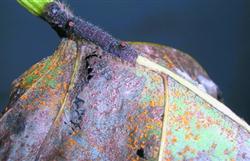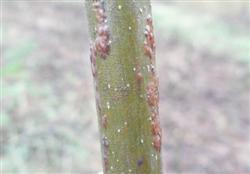Skin rot of poplar and its control

Poplar skin rot: the symptoms of poplar rot occur on the trunk and branches, showing two types of dry rot and withered branches: dry rot mainly occurs in the trunk, big branches and branch bifurcations. At the initial stage, the disease showed dark brown edematous spots, the cortical tissue decayed and softened, and the bark dried and sunken after dehydration, sometimes cracked, with obvious dark brown edges. In the later stage, there are many needle-shaped black protuberances on the disease spot, that is, the fungal conidia, from which the orange-red filamentous conidial horn is extruded when it is wet. Under suitable conditions, the disease spot expands rapidly, and when the disease spot surrounds the tree trunk for one week, the upper part of the disease spot dies. The lesion cortex becomes dark brown and rotten, sometimes reaching xylem, which is easy to peel off from xylem. When the environmental conditions are favorable for the growth of trees, the disease resistance is improved, and callus can grow around the disease spot to prevent the expansion of the disease spot. The withered tip type mainly occurred on the branches of 1-4-year-old young trees or big trees. at the initial stage, the diseased part was dark gray, and the symptoms were not obvious. when the diseased part rapidly expanded around the branches for a week, the upper part withered and died. Since then, there are many small black spots on the withered branches, that is, the conidium of the pathogen. The pathogens overwintered in the diseased tissue with hyphae, conidia or ascomycetes. In the following spring, when the temperature (10-15.2) and humidity (60% Mur80%) are suitable, conidia are produced for transmission, and the spores germinate and invade the host tissue through various wounds with an incubation period of 6-10 days. The disease begins in the middle and last ten days of March every year, new disease spots are formed, and the old disease spots continue to expand. The peak period of the disease was from mid-April to late May, and the development stopped in October. The two pathogenic fungi of poplar skin rot are weak parasites, which can only infect trees with poor growth and weak tree potential. The bacteria first live in a variety of wounds or weakened parts, and gradually infect the living tissue. The water content of bark is closely related to the disease. Low water content of bark is beneficial to the occurrence of the disease, and the pathogen can live saprophytic life on dead trees for a long time. All the environmental factors that are not conducive to poplar growth, such as climate, soil conditions, inhibition, extensive management, and other diseases and insect pests can lead to the occurrence of the disease. The main points of prevention and control are big trees with serious diseases, which can be scraped off and treated with medicine. The rest are the same as poplar canker.
- Prev

Fertilization technique of Poplar
Poplar skin rot (rot) mainly occurs on the trunk and branches of poplar. After the onset of the disease, the cortical tissue of the trunk and branches rotted, lost water, sunken, cracked, and smelled of wine lees. When the diseased part surrounds the trunk or branch for a week, the whole upper part of the tree dies. The disease occurs twice a year, when the temperature is above 7 ℃.
- Next

Harm and control measures of skin rot of poplar
Poplar skin rot is a common and frequently-occurring disease, which does great harm to poplar, willow, elm and other tree species. The disease is a latent infectious disease. When drought, waterlogging, sunburn, frost injury and other bad conditions occur, and it is not easy to restore the vitality of trees after seedling transplantation or intensity pruning, the disease occurs quickly and affects the growth of trees.
Related
- Fuxing push coffee new agricultural production and marketing class: lack of small-scale processing plants
- Jujube rice field leisure farm deep ploughing Yilan for five years to create a space for organic food and play
- Nongyu Farm-A trial of organic papaya for brave women with advanced technology
- Four points for attention in the prevention and control of diseases and insect pests of edible fungi
- How to add nutrient solution to Edible Fungi
- Is there any good way to control edible fungus mites?
- Open Inoculation Technology of Edible Fungi
- Is there any clever way to use fertilizer for edible fungus in winter?
- What agents are used to kill the pathogens of edible fungi in the mushroom shed?
- Rapid drying of Edible Fungi

